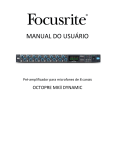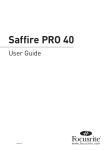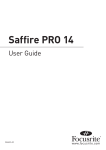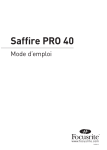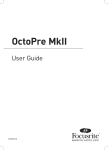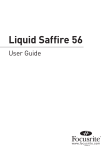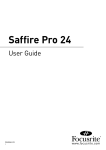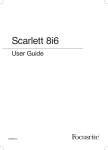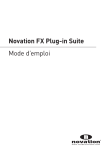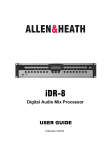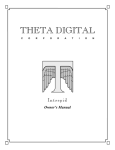Download Using the OctoPre MkII Dynamic
Transcript
OctoPre MkII
Dynamic
User Guide
Mode d'emploi
FA0346-03
1
Important Safety Instructions
1. Read these instructions.
2. Keep these instructions.
3. Heed all warnings.
4. Follow all instructions.
5. Do not use this apparatus near water.
6. Clean only with dry cloth.
7.
Do not block any ventilation openings. Install in accordance with the manufacturer’s instructions.
8. Do not install near any heat sources such as radiators, heat registers, stoves, or other apparatus (including amplifiers) that
produce heat.
9.
Do not defeat the safety purpose of the polarized or grounding-type plug. A polarized plug has two blades with one wider than
the other. A grounding type plug has two blades and a third grounding prong. The wide blade or the third prong are provided for
your safety. If the provided plug does not fit into your outlet, consult an electrician for replacement of the obsolete outlet.
10. Protect the power cord from being walked on or pinched particularly at plugs, convenience receptacles, and the point where
they exit from the apparatus.
11. Only use attachments/accessories specified by the manufacturer.
12. Use only with the cart, stand, tripod, bracket, or table specified by the manufacturer, or sold with the apparatus. When a cart is
used, use caution when moving the cart/apparatus combination to avoid injury from tip-over.
13. Unplug this apparatus during lightning storms or when unused for long periods of time.
14. Refer all servicing to qualified service personnel. Servicing is required when the apparatus has been damaged in any way, such
as power-supply cord or plug is damaged, liquid has been spilled or objects have fallen into the apparatus, the apparatus has
been exposed to rain or moisture, does not operate normally, or has been dropped.
WARNING: To reduce the risk of fire or electric shock, do not expose this apparatus to rain or moisture.
It is important that the apparatus shall not be exposed to dripping or splashing and that no objects filled with liquids, such as vases
shall be placed on the apparatus.
•
Do not expose this apparatus to drips or splashes.
•
Do not place any objects filled with liquids, such as vases, on the apparatus.
•
Do not install this apparatus in a confined space such as a bookcase or similar unit.
•
Slots and openings in the cabinet are provided for ventilation and to ensure reliable operation of the product and to protect it
from overheating. Please ensure adequate space around the apparatus for sufficient ventilation. Ventilation should not be impeded by covering the ventilation openings with items such as newspapers, tablecloths curtains etc.
•
The apparatus draws nominal non-operating power from the AC outlet with its POWER switch in the off position.
•
The apparatus should be located close enough to the AC outlet so that you can easily grasp the power cord plug at any time.
•
An apparatus with Class 1 construction shall be connected to an AC outlet with a protective grounding connection.
•
The MAINS plug or the appliance coupler is used as the disconnect device. Either device shall remain readily operable when the
apparatus is installed for use.
•
No naked flames, such as lighted candles, should be placed on the apparatus.
WARNING: excessive sound pressure levels from earphones and headphones can cause hearing loss.
GB
GB This equipment must be earthed by the power cord
FIN
FIN Laite on liitettävä suojamaadoituskoskettimilla varustettuun pistorasiaan
NOR
NOR 2
Apparatet må kun tilkoples jordet stikkontakt
Important Safety Precautions
CAUTION: TO REDUCE THE RISK OF ELECTRIC SHOCK, DO NOT REMOVE
COVER (OR BACK). NO USER-SERVICEABLE PARTS INSIDE.
REFER SERVICING TO QUALIFIED SERVICE PERSONNEL.
The lightning flash with arrowhead symbol, within equilateral triangle, is
intended to alert the user to the presence of uninsulated “dangerous voltage” within the product’s enclosure that may be of sufficient magnitude to
constitute a risk of electric shock to persons.
The exclamation point within an equilateral triangle is intended to alert the
user to the presence of important operating and maintenance (servicing)
instructions in the literature accompanying the appliance.
WARNING: TO PREVENT FIRE OR SHOCK HAZARD, DO NOT EXPOSE THIS APPLICANCE
TO RAIN OR MOISTURE
Environmental Declaration
Compliance Information Statement: Declaration of Compliance procedure
Product Identification: Focusrite OctoPre MkII Dynamic
Responsible party:
American Music and Sound
Address:
5304 Derry Avenue #C
Agoura Hills,
CA 91301
Telephone:
800-994-4984
This device complies with part 15 of the FCC Rules. Operation is subject to the following two conditions: (1) This device may not cause harmful
interference, and (2) this device must accept any interference received, including interference that may cause undesired operation.
For USA To the User:
1.
Do not modify this unit! This product, when installed as indicated in the instructions contained in this manual, meets FCC requirements. Modifications not expressly approved by Focusrite may void your authority, granted by the FCC, to use this product.
2.
Important: This product satisfies FCC regulations when high quality shielded cables are used to connect with other equipment. Failure to use high quality shielded cables or to follow the installation instructions within this manual may cause magnetic interference with appliances such
as radios and televisions and void your FCC authorization to use this product in the USA.
3.
Note: This equipment has been tested and found to comply with the limits for a Class B digital device, pursuant to part 15 of the FCC Rules.
These limits are designed to provide reasonable protection against harmful interference in a residential installation. This equipment generates, uses and can radiate radio frequency energy and, if not installed and used in accordance with the instructions, may cause harmful interference to radio communications. However, there is no guarantee that interference will not occur in a particular installation. If this equipment
does cause harmful interference to radio or television reception, which can be determined by turning the equipment off and on, the user is
encouraged to try to correct the interference by one or more of the following measures:
•
Reorient or relocate the receiving antenna.
•
Increase the separation between the equipment and receiver.
•
Connect the equipment into an outlet on a circuit different from that
•
to which the receiver is connected.
Focusrite Audio Engineering Limited has conformed
•
Consult the dealer or an experienced radio/TV technician for help.
and this product conforms, where applicable, to the
RoHS Notice
European Union’s Directive 2002/95/EC on RestricFor Canada To the User:
This Class B digital apparatus complies with Canadian ICES-003
Cet appareil numérique de la classe B est conforme à la norme NMB-003 du Canada.
tions of Hazardous Substances (RoHS) as well as
the following sections of California law which refer
to RoHS, namely sections 25214.10, 25214.10.2, and
58012, Health and Safety Code; Section 42475.2,
Public Resources Code.
3
Contents
Introduction................................................................................................................... 4
Box Contents................................................................................................................. 4
Hardware....................................................................................................................... 5
Back Panel............................................................................................................ 5
Front Panel............................................................................................................ 5
Using the OctoPre MkII Dynamic.................................................................................... 6
Combo Inputs........................................................................................................ 6
Phantom Power..................................................................................................... 6
Preamp Gain.......................................................................................................... 6
Compressor.......................................................................................................... 6
Compressor - Detailed Information...................................................................... 7
Line Outputs.......................................................................................................... 8
5 LED Metering...................................................................................................... 8
Digital Outputs...................................................................................................... 8
Digital Inputs......................................................................................................... 8
Digital Synchronisation......................................................................................... 9
Example Setups............................................................................................................10
Specifications...............................................................................................................13
Troubleshooting...........................................................................................................14
Mode d'emploi (français)..............................................................................................15
Introduction
Thank you for purchasing the Focusrite OctoPre MkII Dynamic. This unit will provide 8 channels of high quality Focusrite preamplifiers for you to use on microphone, line and instrument signals. You can use the OctoPre MkII Dynamic as part of your studio
set-up or live rig. The OctoPre MkII Dynamic offers 8 direct outputs via the balanced line outputs to connect to an analogue device,
or via a single or dual ADAT connection to a digital device.
If the main User Guide sections do not provide the information you need, be sure to consult http://www.focusrite.com/answerbase,
which contains a comprehensive list of common technical support queries regarding the product to date.
Box Contents
Along with your OctoPre MkII Dynamic you should have:
1 - IEC power cable
4 - Self-adhesive rubber feet - stick to the bottom of the unit for table-top placement
1 - Registration Card
1 - Focusrite / Novation Product Brochure
4
Hardware
Back Panel
The back panel provides the all of the input and output connections on the OctoPre MkII Dynamic.
5
7
1
2
3
4
5
6
7
4
6
3
1
2
8 x Combo inputs for Inputs 1 - 8. Mic via XLR or Line via Jack*
8 x Line outputs (1 - 8)*
2 x Optical input sockets **
2 x Optical output sockets **
1 x BNC Word Clock input connector
1 x BNC Word Clock output connector
1 x IEC Power input socket
* Either 1/4 inch TRS (balanced) or TS (unbalanced) Jack connectors can be used.
** @ sample rates of 44.1 / 48 kHz use either output port 1 or port 2 for 8 channels - ADAT (a copy is sent to both ports)
@ sample rates of 88.2 / 96 kHz use output port 1 and 2 for 2 x 4 channels - ADAT SMUX.
Front Panel
1
9
1
2
3
4
5
6
7
8
9
2
4
3
6
5
8
7
9
Preamp Gain and Compression Compress and More controls for Inputs 1 - 8
Separate 5 LED meter for each input channel -42, -18, -6, -3, 0 dBFS. (NOTE: Metering is post preamp and compression)
The Mic 48V Phantom Power switches with LEDs for Channels 1-4 and 5-8
Inst Instrument switch with LEDs for inputs 1 and 2
Sample Rate switch with separate LEDs for each sample rate
Clock Source switch with separate LEDs for sync source / status
AD DA Switch to route ADAT input to line outputs
Power switch with LED - LED is lit when the unit receives power and is turned on
Removable rack-ear covers - remove to install unit into a 19 inch rack
5
Using the OctoPre MkII Dynamic
Combo Inputs
All eight of the analogue audio inputs use professional combo connectors. These can accept male XLR connectors,
TS (un-balanced) and TRS (balanced) jack connectors.
If an XLR cable is used, then the preamp will automatically switch to microphone level.
If a jack cable is connected, then the preamp will automatically switch to line level. For instrument signals connected to
inputs 1 and 2 use the Inst button to switch to high impedance instrument level.
Phantom Power (MIC 48V)
The two phantom power switches turn on 48V phantom power to Mic inputs 1-4 and 5-8. Phantom power is required for
most condenser (capacitor) microphones. Phantom power is only sent to the XLR connector on the combo inputs, so if a
group of 4 preamps is shared between mic and line level signals, +48V is only sent to the microphones.
Dynamic microphones do not require phantom power but most will operate with phantom power supplied.
Ribbon microphones do not require phantom power and may be damaged if supplied with phantom power.
If you are unsure about your microphone DO NOT supply phantom power until you have confirmed the specifications with the
manufacturer.
Preamp Gain
The gain of each preamp should be set with reference to the level of the input source. Use the LED metering to monitor the signal
level of each preamp.
Start with the preamp gain set to minimum. Ensure that the compression is set to off. Ask the recording artist to
play at the loudest level required by the performance.
The O/L LED will light if the signal level is too high. If the signal causes the O/L LED to light, even with the gain
set to a minimum then compression will be required.
Compression can also be applied to signals that don't overload the preamp, but require an amount of 'levelling' of the dynamics.
Compressor
The Compress control allows compression to be applied to the signal. With the control fully anti-clockwise, the compressor is set
Off: no compression is applied.
To turn on the compressor, rotate the Compress dial clockwise. As soon as the dial is moved from the Off position the yellow Comp
LED will briefly light to indicate that the compressor is now active. As the control is turned further clockwise, the compression
threshold is progressively reduced, resulting in heavier and heavier compression of the signal. Now the yellow Comp LED will light
whenever compression is being applied to the signal.
A compressor acts as an automatic volume control, effectively turning down the volume of a signal if it gets too loud. As the
Compress dial is turned clockwise, the make-up gain is progressively increased, bringing up the overall signal level.
The More button will provide a greater ratio, thereby applying heavier compression to the signal.
6
Compressor - Detailed information.
The following graphs show the compression curve for normal and more modes. These graphs include the effect of the make-up
gain to the overall signal level. The four lines represent Compress Off (OFF), Compress On - Min (MIN), Mid (MID) and Max (MAX)
settings.
In both modes the attack time is 1.2ms. The release time the 28ms
Prism Sound dScope Series III
Page 1 of 1
Normal Mode
OPE Dynamic Compression Curves
dBFS
10.00
OFF
MIN
MID
0.00
-10.00
MAX
-20.00
MAX
MID
-30.00
-40.00
MIN
-50.00
OFF
-60.00
-60.00 dBr
-50.00
-40.00
-30.00
-20.00
-10.00
0.00
In Normal mode (More button switched out) the compression ratio is 2:1
Prism Sound dScope Series III
Page 1 of 1
OPE Dynamic
Compression
More
Mode Curves
dBFS
10.00
OFF
MIN
MID
0.00
-10.00
MAX
-20.00
-30.00
MAX
MID
MIN
-40.00
-50.00
OFF
-60.00
-60.00 dBr
-50.00
-40.00
-30.00
-20.00
-10.00
0.00
In More mode (More button switched in) the compression ratio is 4:1
In both modes, as the Compress dial is turned clockwise, the threshold is reduced and the make-up gain increased. As More mode
utilises a higher ratio (hence more compression) there is more make-up gain to compensate.
7
Line Outputs
Use the line outputs to connect the OctoPre MkII Dynamic to the line inputs of any analogue device.
The OctoPre MkII Dynamic will accept either TS (unbalanced) or TRS (balanced) jacks.
TRS jacks will give a maximum signal level of +16dBu whereas TS jacks will give a maximum level of +10dBu.
These analogue output levels correspond to 0dBFS.
NOTE: When the AD DA button is switched in, the line outputs are switched to output the signal received at the ADAT inputs (see
below).
5 LED Metering
The 8 x 5 LED meters show the level of the signal just before it reaches the analogue to digital
Converters - i.e after both the preamp and compressor.
Each LED represents the following values in dBFS: -42, -18, -6 (Green), -3 (Yellow), 0 (Red).
When connected to a digital device, you should ensure that both the preamp and compressor settings
are such that the signal level never reaches 0dBFS (Red).
Digital Outputs
Use the ADAT output(s) to connect the OctoPre MkII Dynamic to the ADAT input(s) of any digital device.
The OctoPre MkII Dynamic will send 8 channels of audio at 44.1 / 48kHz via a single optical cable. The same 8
channels are sent to both optical output ports.
The OctoPre MkII Dynamic will send 4 channels of audio at 88.2 / 96kHz via a single optical cable. Channels 1-4 and
5-8 are sent out of optical ports 1 & 2 respectively.
Use the Sample Rate button to select the desired sample rate. You must ensure that the sample rate selected on the OctoPre MkII
Dynamic matches the sample rate set on all connected digital devices.
Digital Inputs
The OctoPre MkII Dynamic will also act as a digital to analogue converter. For example, if you are using the OctoPre
MkII Dynamic with a computer audio interface, then you can connect the interface ADAT outputs to the ADAT inputs of
the OctoPre MkII Dynamic, thus increasing the number of analogue outputs from your computer.
Press the AD DA button to send the digital ADAT input to the 8 Line outputs.
NOTE: The analogue to digital and digital to analogue converters are synchronised to the same clock source. This means that both
must run at the same sample rate.
8
Digital Synchronisation
There are a number of synchronisation options available:
OctoPre MkII Dynamic as clock source master - ADAT:
Connect the OctoPre MkII Dynamic's ADAT output to the digital device's ADAT input and ensure that the receiving device is set to
receive clock from it's ADAT input (also ensuring the sample rates on both devices are matched).
The OctoPre MkII Dynamic's Clock Source should be set to Internal and the Locked LED will light up green.
OctoPre MkII Dynamic as clock source master - word clock:
Connect the OctoPre MkII Dynamics ADAT and word clock outputs to the digital device's ADAT and word clock inputs and ensure that
the receiving device is set to receive clock from the word clock input (also ensuring the sample rates on both devices are matched).
The OctoPre MkII Dynamic Clock Source should be set to Internal and the Locked LED will light up green.
NOTE: The ADAT connection will transmit the digital audio; the word clock is only providing the synchronisation.
OctoPre MkII Dynamic as Clock Source Slave - ADAT:
Connect the OctoPre MkII Dynamic ADAT output to the digital device's ADAT input. Connect the digital device's ADAT output to the
OctoPre MkII Dynamic's ADAT input (also ensuring the sample rates on both devices are matched).
The OctoPre MkII Dynamic Clock Source should be set to ADAT and the Locked LED will light up Green.
OctoPre MkII Dynamic as Clock Source Slave - word clock:
Connect the OctoPre MkII Dynamic's ADAT output to the digital device's ADAT input and connect a BNC cable from the digital device
(or any other device in the digital chain) to the OctoPre MkII Dynamic's word clock input (also ensuring the sample rates on both
devices are matched).
The OctoPre MkII Dynamic Clock Source should be set to word clock and the Locked LED will light up Green.
NOTE: The OctoPre MkII Dynamic's word clock input is termintated (75Ω). Therefore the OctoPre MkII Dynamic should be the last
device in a chain of word clock connected digital devices.
See the following Example Setups section for digital synchronisation examples:
9
Example Setups
OctoPre MkII Dynamic with Audio Interface: OctoPre MkII Dynamic as Clock Source Master
Here the OctoPre MkII Dynamic is connected to a Focusrite Saffire Pro 40. Both units are running at 44.1kHz. The setup principle will
be the same with any other audio interface with an ADAT input.
OctoPre MkII Dynamic with Audio Interface: Audio Interface as Clock Source Master
Here the OctoPre MkII Dynamic is connected to a Focusrite Liquid Saffire 56. Both units are running at 44.1kHz. The setup principle
will be the same with any other audio interface with ADAT input and word clock output.
10
OctoPre MkII Dynamic with Audio Interface - AD / DA Mode.
Here the OctoPre MkII Dynamic is connected to a Focusrite Liquid Saffire 56. Both units are running at 44.1kHz. Two ADAT cables
are used to send 8 channels of audio each way. The setup principle will be the same with any other audio interface with ADAT input
and output.
OctoPre MkII Dynamic with Audio Interface - SMUX mode.
Here the OctoPre MkII Dynamic is connected to a Focusrite Liquid Saffire 56. Both units are running at 96kHz. Two ADAT cables are
used to send 4 channels of audio each. The setup principle will be the same with any other audio interface with 2 ADAT inputs and
word clock output.
11
OctoPre MkII Dynamic with Analogue Mixing Desk
Connect the OctoPre MkII Dynamic's 8 analogue outputs to any analogue device's 8 inputs using TS or TRS jacks.
OctoPre MkII Dynamic with Analogue Mixing Desk and Digital Record / Backup (44.1 / 48 kHz)
The OctoPre MkII Dynamic can output to both analogue and digital devices simultaneously. Here the line outputs connect to the
mixing desk (live monitor), ADAT output 1 to Saffire PRO 40 (record device), and ADAT output 2 to the second Saffire Pro 40 (record 2
/ backup device).
Note that this will work at sample rates of 44.1 and 48kHz.
At 88.2 and 96kHz 2 ADAT cables are required to transmit 8 channels of audio. (4 channels per cable).
12
Performance Specifications
MIC
•
•
•
•
Frequency response: 20Hz - 20kHz +/- 0.1 dB.
Maximum input level (Gain at Minimum): +16dBu.
THD+N: 0.001% (measured at 1kHz with a 20Hz/22kHz bandpass filter).
Noise: EIN > 125dB (128dB analogue to digital): measured at ~60dB of gain with 150 Ohm termination (20Hz/22kHz bandpass filter).
LINE
•
•
•
Frequency response: 20Hz - 20kHz +/- 0.1dB.
THD+N: < 0.001% (measured with 0dBFS input and 22Hz/22kHz bandpass filter).
Noise: -90dBu (22Hz/22kHz bandpass filter).
INSTRUMENT
•
•
•
Frequency response: 20Hz - 20kHz +/- 0.1dB.
THD+N: 0.004% (measured with 0dBu input and 20Hz/22kHz bandpass filter).
Noise: -87dBu (20Hz/22kHz bandpass filter).
DIGITAL PERFORMANCE
•
•
•
•
•
•
•
Clock sources:
Internal clock.
Sync to word clock Input.
Sync to ADAT Input (ADAT 1 input only).
A/D dynamic range 110dB 'A-weighted' (all inputs).
D/A dynamic range 110dB 'A-weighted' (all outputs).
JetPLLTM PLL technology providing superb jitter reduction for class leading converter performance.
Clock jitter < 250 pico seconds.
Sample rates: 44.1kHz to 96kHz.
Sample rate clock accuracy: +/-20PPM.
ANALOGUE INPUTS
•
•
•
•
•
•
•
•
•
•
Mic / line inputs on XLR combo with auto-switching between mic (XLR) and line / instrument (TRS).
Mic / line / instrument 1 & 2: 2 x XLR Combo on rear panel.
Mic / line 3-8: 6 x XLR combo.
Instrument: As above, switched to instrument (inputs 1 & 2 only).
Mic gain: +10dB to + 55dB.
Line 1-8 gain: -10dB to +36dB.
Instrument gain: +10dB to +55dB.
Phantom power switched in 4 channel groups on mic 1-4 and 5-8.
Mic and instrument maximum input level +16dBu.
Line maximum input level +26dBu.
COMPRESSORS
•
•
•
•
•
•
Threshold range: -44dBFS (Max setting) to -4dBFS (Min setting).
Compression ratio: Normal - 2:1, More: 4:1.
Auto make-up gain: 4dB (min setting), 18dB (max setting).
Attack time: 1.2ms, release time: 28ms (-3.5dB method).
Compression curve: classic focusrite soft knee.
THD+N (maximum at any compression threshold, input < +16dBu, gain at minimum): < 0.18%
13
ANALOGUE OUTPUTS
•
•
•
•
•
Line level 8 x 1/4” TRS Jack.
Nominal output level 0dBFS = 16dBu, balanced.
Frequency response: 20Hz – 20kHz +/- 0.2dB.
THD+N < 0.0010% (-100dB) (measured with 0dBFS input 22Hz/22kHz bandpass filter, un-weighted).
Switching to enable monitoring of A/D inputs or ADAT inputs with ADDA switch.
DIGITAL I/O
•
•
ADAT Out 1 & 2: 8 channels (44.1 / 48kHz), 4 channels SMUX (88.2 / 96kHz, 8 channels total).
ADAT In 1 & 2: 8 channels (44.1 / 48kHz, ADAT 1 only), 4 channels SMUX (88.2 / 96kHz, 8 channels total).
POWER
•
Internal universal input PSU.
FRONT PANEL INDICATORS
•
•
•
•
•
Metering of analogue inputs (channels 1-8), 5 segment (-42, -18, -6, -3 and 0dBFS).
4 sample rate LED’s (44.1k, 48k, 88.2k & 96k).
3 sync source LED’s (Internal, Word Clock and ADAT).
‘Lock’ indicator LED.
ADDA switch for analogue output source selection (A/D’s or ADAT inputs).
WEIGHT and DIMS
•
3kg - 35cm x 4.5cm x 26.5cm.
Troubleshooting
For all troubleshooting queries, please visit the 'Focusrite Answerbase' where there are articles covering numerous
troubleshooting examples. www.focusrite.com/answerbase.
Focusrite is a registered trade mark of Focusrite Audio Engineering Limited.
OctoPre is a trade mark of Focusrite Audio Engineering Limited.
2009 – 2010 © Focusrite Audio Engineering Limited. All rights reserved
14
OctoPre MkII
Dynamic
Mode d’emploi
FA0346-03
15
Instructions de sécurité importantes
1. Lisez ces instructions.
2. Conservez ces instructions.
3. Tenez compte de tous les avertissements.
4. Suivez toutes les instructions..
5. N’utilisez pas cet appareil avec de l’eau à proximité.
6. Nettoyez-le uniquement avec un chiffon doux.
7.
Ne bloquez aucune ouverture de ventilation. Installez-le conformément aux instructions du fabricant.
8. Ne l’installez pas près d’une source de chaleur de type radiateur, bouche de chaleur, poêle ou autre appareil (dont des
amplificateurs) qui produit de la chaleur.
9.
Ne supprimez pas le dispositif de sécurité que représente la fiche polarisée ou de terre. Une fiche polarisée a deux lames dont
une plus large que l’autre. Une fiche de terre a deux bornes et une troisième pour la terre. La lame large ou la borne de terre
servent à votre sécurité. Si la fiche fournie ne rentre pas dans votre prise, consultez un électricien pour le remplacement de la
prise obsolète.
10. Évitez que le cordon d’alimentation ne soit piétiné ou pincé, particulièrement au niveau des fiches, des multiprises et de la
sortie de l’appareil.
11. N’utilisez que des fixations/accessoires spécifiés par le fabricant.
12. N’utilisez qu’un chariot, stand, trépied, fixation ou table spécifié par le fabricant, ou vendu avec l’appareil. Si vous utilisez un
chariot, prenez garde lors du déplacement de l’ensemble chariot/appareil à ne pas être blessé par un renversement..
13. Débranchez cet appareil durant les orages ou en cas de non utilisation prolongée.
14. Confiez toute réparation à un personnel de maintenance qualifié. Une réparation est nécessaire si l’appareil a été endommagé
de quelque façon que ce soit, notamment si le cordon d’alimentation ou sa fiche sont endommagés, si du liquide a été renversé
sur l’appareil ou si des objets sont tombés à l’intérieur, si l’appareil est exposé à la pluie ou à l’humidité, ne fonctionne pas
normalement ou est tombé.
AVERTISSEMENT: pour réduire le risque d’incendie ou de choc électrique, n’exposez pas cet appareil à la pluie ni à l’humidité..
•
Il est important que l’appareil ne soit pas exposé au ruissellement, aux éclaboussures et qu’aucun objet rempli de liquide,
comme un vase, ne soit posé sur l’appareil
•
N’exposez pas cet appareil au ruissellement ni aux éclaboussures.
•
Ne placez aucun objet rempli de liquide sur l’appareil, comme un vase.
•
N’installez pas cet appareil dans un espace confiné comme une bibliothèque ou meuble similaire.
•
Les fentes et ouvertures du boîtier sont prévues pour la ventilation et afin d’assurer un fonctionnement fiable du produit
en l’empêchant de surchauffer. Veuillez assurer un espace adéquat autour de l’appareil pour une ventilation suffisante. La
ventilation ne doit pas être gênée par des objets tels que journaux, nappes, rideaux etc. obstruant les ouvertures de ventilation.
•
L’appareil tire une tension nominale non fonctionnelle de la prise secteur quand son interrupteur d’alimentation POWER est en
position off.
•
L’appareil doit être situé suffisamment près de la prise secteur pour que vous puissiez aisément saisir la fiche d’alimentation à
tout moment.
•
Un appareil de construction Classe 1 doit être branché à une prise secteur disposant d’une mise à la terre de protection.
•
La fiche d’alimentation secteur ou le cordon de l’alimentation servent de dispositifs de déconnexion. L’un et l’autre doivent
rester accessibles quand l’appareil est installé pour l’utilisation.
•
Aucune flamme nue, comme une bougie allumée, ne doit être placée sur l’appareil.
AVERTISSEMENT: des niveaux de pression sonore excessifs au casque et dans des écouteurs peuvent entraîner une perte auditive.
GB
FIN
This equipment must be earthed by the power cord
NOR
Apparatet må kun tilkoples jordet stikkontakt
16
Laite on liitettävä suojamaadoituskoskettimilla varustettuun pistorasiaan
Précautions importantes de sécurité
ATTENTION : POUR RÉDUIRE LE RISQUE DE CHOC ÉLECTRIQUE, NE
RETIREZ PAS LE CAPOT (NI LE DOS). AUCUNE PIÈCE N’EST RÉPARABLE
PAR L’UTILISATEUR À L’INTÉRIEUR. CONFIEZ TOUTE RÉPARATION À DU
PERSONNEL DE MAINTENANCE QUALIFIÉ.
Le symbole d’éclair à pointe de flèche dans un triangle équilatéral est
destiné à alerter l’utilisateur de la présence d’une “tension dangereuse”
non isolée dans l’enceinte du produit, tension d’amplitude suffisante pour
constituer un risque d’électrocution pour les personnes.
Le point d’exclamation dans un triangle équilatéral est destiné à alerter
l’utilisateur de la présence d’instructions importantes de fonctionnement
et de maintenance (réparation) dans la documentation accompagnant
l’appareil.
AVERTISSEMENT : POUR PRÉVENIR TOUT DANGER D’INCENDIE OU DE CHOC, N’EXPOSEZ PAS CET APPAREIL À LA
PLUIE NI À L’HUMIDITÉ.
Environmental Declaration
Compliance Information Statement: Declaration of Compliance procedure
Product Identification: Focusrite OctoPre MkII Dynamic
Responsible party:
American Music and Sound
Address:
5304 Derry Avenue #C
Agoura Hills,
CA 91301
Telephone:
800-994-4984
This device complies with part 15 of the FCC Rules. Operation is subject to the following two conditions: (1) This device may not cause harmful
interference, and (2) this device must accept any interference received, including interference that may cause undesired operation.
For USA To the User:
1.
Do not modify this unit! This product, when installed as indicated in the instructions contained in this manual, meets FCC requirements. Modifications not expressly approved by Focusrite may void your authority, granted by the FCC, to use this product.
2.
Important: This product satisfies FCC regulations when high quality shielded cables are used to connect with other equipment. Failure to use
high quality shielded cables or to follow the installation instructions within this manual may cause magnetic interference with appliances such
as radios and televisions and void your FCC authorization to use this product in the USA.
3.
Note: This equipment has been tested and found to comply with the limits for a Class B digital device, pursuant to part 15 of the FCC Rules.
These limits are designed to provide reasonable protection against harmful interference in a residential installation. This equipment generates, uses and can radiate radio frequency energy and, if not installed and used in accordance with the instructions, may cause harmful interference to radio communications. However, there is no guarantee that interference will not occur in a particular installation. If this equipment
does cause harmful interference to radio or television reception, which can be determined by turning the equipment off and on, the user is
encouraged to try to correct the interference by one or more of the following measures:
•
Reorient or relocate the receiving antenna.
•
Increase the separation between the equipment and receiver.
•
Connect the equipment into an outlet on a circuit different from that to which the receiver is connected.
•
Consult the dealer or an experienced radio/TV technician for help.
For Canada To the User:
RoHS Notice
This Class B digital apparatus complies with Canadian ICES-003
Focusrite Audio Engineering Limited has conformed
Cet appareil numérique de la classe B est conforme à la norme NMB-003 du Canada.
and this productconforms, where applicable, to the
European Union’s Directive 2002/95/EC on Restrictions of Hazardous Substances (RoHS) as well as
the following sections of California law which refer
to RoHS, namely sections 25214.10, 25214.10.2, and
58012, Health and Safety Code; Section 42475.2,
Public Resources Code.
17
Sommaire
Introduction................................................................................................................. 18
Contenu de l’emballage............................................................................................... 18
Interface...................................................................................................................... 19
Face arrière......................................................................................................... 19
Face avant........................................................................................................... 19
Emploi de l'OctoPre MkII Dynamic............................................................................... 20
Entrées mixtes.................................................................................................... 20
Alimentation fantôme.......................................................................................... 20
Gain du préampli................................................................................................. 20
Compresseur....................................................................................................... 20
Compresseur - Informations détaillées.............................................................. 21
Sorties ligne........................................................................................................ 22
Mesure de niveau à 5 DEL.................................................................................... 22
Sorties numériques............................................................................................. 22
Entrées numériques............................................................................................ 22
Synchronisation numérique................................................................................ 23
Exemples de configuration.......................................................................................... 24
Caractéristiques techniques........................................................................................ 27
Guide de dépannage.................................................................................................... 28
Introduction
Merci d'avoir choisi l'OctoPre MkII Dynamic de Focusrite. Cette unité vous apporte 8 canaux à préamplificateurs Focusrite de haute
qualité pour l'emploi avec des signaux de type microphone, ligne et instrument. Vous pouvez utiliser l'OctoPre MkII Dynamic dans
votre installation de studio ou dans votre équipement de scène. L'OctoPre MkII Dynamic offre 8 sorties directes via les sorties ligne
symétriques pour une connexion à un appareil analogique, ou via une connexion ADAT simple ou double avec un appareil numérique.
Si les principales sections du mode d’emploi ne vous apportent pas les informations dont vous avez besoin, pensez à consulter http://
www.focusrite.com/answerbase, qui contient une liste complète des questions les plus fréquemment posées à ce jour à l’assistance
technique à propos de ce produit.
Contenu de l’emballage
Avec votre OctoPre Mk II Dynamic, vous devez avoir :
1 - câble d’alimentation électrique IEC
4 - pieds en caoutchouc auto-adhésifs - collez-les sous l'unité pour la placer sur une table
1 - Carte d'enregistrement
1 - Brochure des produits Focusrite/Novation
18
Interface
Face arrière
La face arrière fournit toutes les connexions d’entrée et de sortie de l'OctoPre MkII Dynamic.
5
7
1
2
3
4
5
6
7
4
6
3
1
2
8 entrées mixtes pour les entrées 1 - 8. Micro par XLR ou ligne par jack*
8 sorties ligne (1 - 8)*
2 prises d'entrée optique **
2 prises de sortie optique **
1 connecteur BNC d'entrée Word Clock
1 connecteur BNC de sortie Word Clock
1 embase d'alimentation IEC
* Des fiches jack 6,35 mm 3 points (TRS/symétriques) ou 2 points (TS/asymétriques) peuvent être employées.
** Aux fréquences d'échantillonnage de 44,1/48 kHz, utilisez le port de sortie 1 ou 2 pour 8 canaux - ADAT (une copie est envoyée aux deux ports)
Aux fréquences d'échantillonnage de 88,2/96 kHz, utilisez les ports 1 et 2 pour 2 x 4 canaux - multiplexage ADAT SMUX.
Face avant
1
9
1
2
3
4
5
6
7
8
9
2
4
3
6
5
8
7
9
Commandes de gain de préampli et de compression pour les entrées 1 - 8
Indicateurs de niveau séparés à 5 DEL pour chaque canal d'entrée : -42, -18, -6, -3, 0 dBFS.
(NOTE : la mesure se fait après le préampli et la compression)
Commutateurs d’alimentation fantôme + 48 V avec DEL pour les canaux 1-4 et 5-8
Commutateurs instrument avec DEL pour les entrées 1 et 2
Sélecteur de fréquence d'échantillonnage avec des DEL séparées pour chaque fréquence d'échantillonnage
Sélecteur de source d'horloge avec des DEL séparées pour chaque source/statut de synchro
Commutateur AD DA pour router l'entrée ADAT vers les sorties ligne
Interrupteur d’alimentation avec DEL - La DEL est allumée quand l'unité reçoit une alimentation et est sous tension
Caches amovibles d'équerres de rack - retirez-les pour une installation dans un rack 19 pouces
19
Emploi de l'OctoPre MkII Dynamic
Entrées mixtes
Les huit entrées audio utilisent les connecteurs mixtes Neutrik. Ils peuvent accepter des connecteurs XLR mâles, des
jacks 6,35 mm 3 points (TRS/symétriques) ou 2 points (TS/asymétriques).
Si un câble XLR est utilisé, alors le préampli est automatiquement réglé sur le niveau microphone.
Si un câble jack est connecté, alors le préampli est automatiquement réglé sur le niveau ligne. Pour les signaux
d'instruments connectés aux entrées 1 et 2, utilisez la touche Inst pour passer en niveau instrument à haute impédance.
Alimentation fantôme (MIC 48V)
Les deux commutateurs d'alimentation fantôme activent l'alimentation fantôme +48 V pour les entrées micro 1-4 et 5-8.
Une alimentation fantôme est requise par la plupart des microphones à condensateur. L'alimentation fantôme n'est envoyée
qu'aux connecteurs XLR des entrées mixtes, donc si un groupe de 4 préamplis est partagé entre signaux de niveau micro et
signaux de niveau ligne, le +48V n'est envoyé qu'aux microphones.
Les microphones dynamiques ne nécessitent pas d'alimentation fantôme, mais la plupart fonctionnent bien avec elle.
Les microphones à ruban ne nécessitent pas d'alimentation fantôme et risquent d'être endommagés s'ils en reçoivent une.
Si vous ne savez pas ce qu'il en est pour votre microphone, ne lui fournissez PAS d'alimentation fantôme avant d'avoir eu confirmation
de ses caractéristiques par le fabricant.
Gain du préampli
Le gain de chaque préampli doit être réglé en fonction du niveau de la source d'entrée. Utilisez l'affichage de niveau à DEL pour
contrôler le niveau du signal de chaque préampli.
Commencez avec le gain du préampli réglé au minimum. Assurez-vous que la compression est réglée sur Off.
Demandez à l'artiste que vous enregistrez de jouer au plus fort niveau requis par son interprétation.
La DEL O/L (saturation) s'allume si le niveau du signal est trop élevé. Si le signal fait s'allumer la DEL O/L même
avec le gain réglé au minimum, une compression sera nécessaire.
La compression peut aussi s'appliquer aux signaux qui ne saturent pas le préampli mais nécessitent d'homogénéiser la dynamique.
Compresseur
La commande Compress permet d'appliquer une compression au signal. Avec la commande à fond dans le sens anti-horaire, le
compresseur est réglé sur Off (hors service) : aucune compression ne s'applique.
Pour mettre en service le compresseur, tournez le bouton Compress dans le sens horaire. Dès que le bouton quitte la position Off, la
DEL Comp jaune s'allume brièvement pour indiquer que le compresseur est maintenant activé. Plus on tourne le bouton dans le sens
horaire, plus le seuil de compression s'abaisse, avec pour résultat une compression de plus en plus forte du signal. À présent, la DEL
Comp jaune s'allume quand de la compression est appliquée au signal.
Un compresseur agit comme une commande de volume automatique, baissant en fait le volume d'un signal s'il est trop fort. Par
conséquent, quand le bouton est tourné dans le sens horaire, le gain de compensation augmente progressivement, faisant remonter le
niveau global du signal.
La touche More procure un taux plus important, donnant donc une compression plus forte du signal.
20
Compresseur - Informations détaillées
Les graphiques suivants représentent la courbe de compression pour les modes Normal et More. Ils comprennent l'effet du gain de
compensation pour le niveau général de signal. Les quatre lignes représentent les réglages de désactivation du compresseur (OFF), de
compresseur au minimum (MIN), à moitié (MID) et au maximum (MAX).
Dans les deux modes, la durée d'attaque est de 1,2 ms. La durée de relâchement est de 28 ms.
Prism Sound dScope Series III
Page 1 of 1
Mode Normal
OPE Dynamic Compression Curves
dBFS
10.00
OFF
MIN
MID
0.00
-10.00
MAX
-20.00
MAX
MID
MIN
-30.00
-40.00
-50.00
OFF
-60.00
-60.00 dBr
-50.00
-40.00
-30.00
-20.00
-10.00
0.00
En mode normal (touche More non enfoncée), le taux de compression est de 2:1.
Prism Sound dScope Series III
Page 1 of 1
OPE Dynamic Compression Curves
Mode More
dBFS
10.00
OFF
MIN
MID
0.00
-10.00
MAX
-20.00
-30.00
MAX
MID
MIN
-40.00
-50.00
OFF
-60.00
-60.00 dBr
-50.00
-40.00
-30.00
-20.00
-10.00
0.00
En mode More (touche More enfoncée), le taux de compression est de 4:1.
Dans les deux modes, quand on tourne le bouton Compress dans le sens horaire, le seuil est réduit et le gain de compensation est
augmenté. Comme le mode More utilise un taux plus important (d'où plus de compression), le gain de compensation est plus élevé.
21
Sorties ligne
Utilisez les sorties ligne pour connecter l'OctoPre MkII Dynamic aux entrées ligne d'un quelconque appareil
analogique.
L'OctoPre MkII Dynamic accepte des jacks 3 points (TRS/symétriques) ou 2 points (TS/asymétriques).
Les jacks 3 points (TRS) donnent un niveau de signal maximum de +16 dBu tandis que les jacks 2 points (TS)
donnent un niveau de signal maximum de +10 dBu. Ces niveaux de sortie analogique correspondent à 0 dBFS.
NOTE : quand la touche AD DA est enfoncée, les sorties ligne sont commutées pour produire le signal reçu aux entrées ADAT (voir cidessous).
Mesure de niveau à 5 DEL
Les 8 indicateurs de niveau à 5 DEL affichent le niveau du signal juste avant qu'il n'atteigne les
convertisseurs analogique-numérique, c'est-à-dire après le préampli et le compresseur.
Chaque DEL représente la valeur suivante en dBFS : -42, -18, -6 (vert), -3 (jaune), 0 (rouge).
En cas de connexion à un appareil numérique, vous devez vous assurer que les réglages du préampli et
du compresseur sont tels que le niveau du signal n'atteint jamais 0 dBFS (rouge).
Sorties numériques
Utilisez les sorties ADAT pour connecter l'OctoPre MkII Dynamic aux entrées ADAT d'un quelconque appareil numérique.
L'OctoPre MkII Dynamic transmettra 8 canaux d'audio à 44,1/48 kHz via un simple câble optique. Les mêmes 8 canaux
sont envoyés aux deux ports optiques.
L'OctoPre MkII Dynamic transmettra 4 canaux d'audio à 88,2/96 kHz via un simple câble optique. Les canaux 1-4 et
5-8 sont respectivement envoyés par les ports optiques 1 & 2.
Utilisez la touche Sample Rate pour sélectionner la fréquence d'échantillonnage désirée. Vous devez vous assurer que
la fréquence d'échantillonnage sélectionnée sur l'OctoPre MkII Dynamic correspond à celle réglée sur tous les appareils numériques
connectés.
Entrées numériques
L'OctoPre MkII Dynamic sert aussi de convertisseur numérique-analogique. Par exemple, si vous utilisez l'OctoPre MkII
Dynamic avec une interface audio informatique, alors vous pouvez relier les sorties ADAT de l'interface aux entrées ADAT
de l'OctoPre MkII Dynamic, augmentant ainsi les sorties analogiques de votre ordinateur.
Enfoncez la touche AD DA pour envoyer l'entrée numérique ADAT aux 8 sorties ligne.
Notez que les convertisseurs analogique-numérique et numérique-analogique sont synchronisés sur la même source d'horloge. Cela
signifie qu'ils doivent tous fonctionner à la même fréquence d'échantillonnage.
22
Synchronisation numérique
Il existe plusieurs options de synchronisation :
L'OctoPre MkII Dynamic comme source d'horloge (maître) - ADAT :
Connectez l'OctoPre MkII Dynamic à l'appareil numérique via ADAT et assurez-vous que l'appareil récepteur est réglé pour recevoir
l'horloge de l'entrée ADAT (vérifiez aussi que les fréquences d'échantillonnage des deux appareils correspondent).
Le sélecteur Clock Source (source d'horloge) de l'OctoPre MkII Dynamic doit être réglé sur Internal (horloge interne) et la DEL Locked
(verrouillée) sera allumée en vert.
L'OctoPre MkII Dynamic comme source d'horloge (maître) - Word clock :
Connectez l'OctoPre MkII Dynamic à l'appareil numérique via ADAT et word clock et assurez-vous que l'appareil récepteur est réglé
pour recevoir l'horloge de l'entrée word clock (vérifiez aussi que les fréquences d'échantillonnage des deux appareils correspondent).
Le sélecteur Clock Source (source d'horloge) de l'OctoPre MkII Dynamic doit être réglé sur Internal (horloge interne) et la DEL Locked
(verrouillée) sera allumée en vert.
NOTE : la connexion ADAT transmettra l'audio numérique. Le signal word clock ne fournit que la synchronisation.
L'OctoPre MkII Dynamic comme esclave de la source d'horloge - ADAT :
Connectez l'OctoPre MkII Dynamic à l'appareil numérique via ADAT. Connectez l'appareil numérique à l'OctoPre MkII Dynamic via ADAT
(en vous assurant là aussi que les fréquences d'échantillonnage des deux appareils correspondent).
Le sélecteur Clock Source (source d'horloge) de l'OctoPre MkII Dynamic doit être réglé sur ADAT et la DEL Locked (verrouillée) sera
allumée en vert.
L'OctoPre MkII Dynamic comme esclave de la source d'horloge - Word clock :
Connectez l'OctoPre MkII Dynamic à l'appareil numérique via ADAT et branchez un câble BNC (depuis l'appareil récepteur ou tout
autre appareil de la chaîne numérique) à l'entrée Word Clock (en vous assurant là aussi que les fréquences d'échantillonnage des deux
appareils correspondent).
Le sélecteur Clock Source de l'OctoPre MkII Dynamic doit être réglé sur Word Clock et la DEL Locked (verrouillée) sera allumée en
vert.
Voir la section suivante, Exemples de configuration, pour des exemples de synchronisation numérique.
23
Exemples de configuration
L'OctoPre MkII Dynamic avec une interface audio : l'OctoPre MkII Dynamic comme source d'horloge
(maître)
Ici, l'OctoPre MkII Dynamic est connecté à une Saffire Pro 40 de Focusrite. Les deux unités fonctionnent à 44,1 kHz. La configuration
sera identique avec toute autre interface audio dotée d'une entrée ADAT.
L'OctoPre MkII Dynamic avec une interface audio : l'interface audio comme source d'horloge
(maître)
Ici, l'OctoPre MkII Dynamic est connecté à une Liquid Saffire 56 de Focusrite. Les deux unités fonctionnent à 44,1 kHz. La configuration
sera identique avec toute autre interface audio dotée d'une entrée ADAT et d'une sortie word clock.
24
L'OctoPre MkII Dynamic avec une interface audio - Mode AD / DA.
Ici, l'OctoPre MkII Dynamic est connecté à une Liquid Saffire 56 de Focusrite. Les deux unités fonctionnent à 44,1 kHz. Deux câbles
ADAT servent à transmettre chacun 8 canaux audio. La configuration sera identique avec toute autre interface audio dotée d'une entrée
et d'une sortie ADAT.
L'OctoPre MkII Dynamic avec une interface audio - Mode SMUX.
Ici, l'OctoPre MkII Dynamic est connecté à une Liquid Saffire 56 de Focusrite. Les deux unités fonctionnent à 96 kHz. Deux câbles ADAT
servent à transmettre chacun 4 canaux audio. La configuration sera identique avec toute autre interface audio dotée de 2 entrées ADAT
et d'une sortie word clock.
25
L'OctoPre MkII Dynamic avec une table de mixage analogique
Connectez l'OctoPre MkII Dynamic à n'importe quel appareil analogique à l'aide de 8 jacks 2 points (TS) ou 3 points (TRS).
L'OctoPre MkII Dynamic avec une table de mixage analogique et enregistrement/sauvegarde
numérique (44,1/48 kHz)
L'OctoPre MkII Dynamic peut approvisionner simultanément des appareils analogiques et numériques. Ici, les sorties ligne sont
raccordées à la table de mixage (retours de scène), la sortie ADAT 1 à la Saffire PRO 40 (enregistreur), et la sortie ADAT 2 à la seconde
Saffire Pro 40 (enregistreur 2/dispositif de sauvegarde).
Notez que cela fonctionnera aux fréquences d'échantillonnage de 44,1 et 48 kHz.
À 88,2 et 96 kHz, les deux câbles ADAT se connectent à un seul appareil (4 canaux par câble).
26
Caractéristiques techniques
MICRO (MIC)
•
•
•
•
Réponse en fréquence : 20 Hz - 20 kHz, +/- 0,1 dB
Niveau d'entrée maximal (gain au minimum) : +16 dBu
DHT+B : 0,001 % (mesurée à 1 kHz avec un filtre passe-bande 20 Hz/22 kHz)
Bruit : équivalent en entrée > 125 dB (128 dB analogique vers numérique) : mesuré à ~60 dB de gain avec terminaison
150 ohms (filtre passe-bande 20 Hz/22 kHz) LIGNE (LINE)
•
•
•
Réponse en fréquence : 20 Hz - 20 kHz, +/- 0,1 dB
DHT+B : < 0,001 % (mesurée avec une entrée à 0 dBFS et un filtre passe-bande 22 Hz/22 kHz)
Bruit : -90 dBu (filtre passe-bande 22 Hz/22 kHz)
INSTRUMENT
•
•
•
Réponse en fréquence : 20 Hz - 20 kHz, +/- 0,1 dB
DHT+B : 0,004% (mesurée avec une entrée à 0 dBu et un filtre passe-bande 20 Hz/22 kHz)
Bruit : -87 dBu (filtre passe-bande 20 Hz/22 kHz)
PERFORMANCES NUMÉRIQUES
•
•
•
•
•
•
•
Sources d'horloge :
Horloge interne
Synchro sur entrée Word Clock
Synchro sur entrée ADAT (entrée ADAT 1 uniquement)
Plage dynamique A/N : 110 dB, "pondération A" (toutes les entrées)
Plage dynamique N/A : 110 dB, "pondération A" (toutes les sorties).
La technologie JetPLL™ procure une remarquable réduction de la gigue pour les meilleures performances de convertisseur
de sa catégorie.
Gigue d'horloge < 250 picosecondes
Fréquences d'échantillonnage : 44,1 à 96 kHz
Précision de l'horloge de fréquence d'échantillonnage : +/-20 PPM
ENTRÉES ANALOGIQUES
•
•
•
•
•
•
•
•
•
•
Entrées micro/ligne sur XLR mixte avec auto-commutation entre micro (XLR) et ligne/instrument (jack 6,35 mm 3 points)
Micro/Ligne/Instrument 1 & 2 : 2 XLR mixtes en face arrière
Micro/Ligne 3-8 : 6 XLR mixtes
Instrument : comme ci-dessus, commutées sur Instrument (entrées 1 & 2 uniquement)
Gain micro : +10 dB à +55 dB
Gain ligne 1-8 : -10 dB à +36 dB
Gain instrument : +10 dB à +55 dB
Alimentation fantôme commutable par groupes de 4 canaux sur entrées micro 1-4 et 5-8
Niveau maximum d'entrée micro et instrument : +16 dBu.
Niveau maximum d'entrée ligne : +22 dBu
COMPRESSEURS
•
•
•
•
•
•
Plage de seuil : -44 dBFS (réglage Max) à -4 dBFS (réglage Min).
Taux de compression, Normal : 2:1, More : 4:1.
Gain automatique de compensation : 4 dB (réglage Min), 18 dB (réglage Max).
Durée d'attaque : 1,2 ms, durée de relâchement : 28 ms (méthode à -3,5 dB).
Courbe de compression : transition douce ("soft knee") classique de Focusrite
DHT+B (maximale à tout seuil de compression, entrée < +16 dBu, gain au minimum) : < 0,18 %
27
SORTIES ANALOGIQUES
•
•
•
•
•
8 prises jack 6,35 mm 3 points de niveau ligne
Niveau de sortie nominal 0 dBFS = 16 dBu, symétrique
Réponse en fréquence : 20 Hz – 20 kHz, +/- 0,2 dB
DHT + B : <0,0010 % (-100 dB) (mesurée avec une entrée à 0 dBFS et un filtre passe-bande 20 Hz/22 kHz, sans pondération)
Commutables pour permettre le monitoring des entrées A/N ou ADAT avec la touche ADDA
ENTRÉES/SORTIES NUMÉRIQUES
•
•
Sorties ADAT 1 & 2 : 8 canaux (44,1/48 kHz), 4 canaux en multiplexage SMUX (88,2/96 kHz, 8 canaux au total)
Entrées ADAT 1 & 2 : 8 canaux (44,1/48 kHz, ADAT 1 uniquement), 4 canaux en multiplexage SMUX
(88,2/96 kHz, 8 canaux au total)
ALIMENTATION
•
Alimentation électrique interne universelle
TÉMOINS EN FACE AVANT
•
•
•
•
•
Indicateurs de niveau des entrées analogiques (canaux 1-8), 5 segments (-42, -18, -6, -3 et 0 dBFS)
4 DEL de fréquence d'échantillonnage (44,1k, 48k, 88,2k & 96k)
3 DEL de source de synchro (Internal, Word Clock et ADAT)
DEL témoin de verrouillage "Locked"
Touche ADDA pour la sélection de source de sortie analogique (entrées A/N ou ADAT)
POIDS et DIMENSIONS
•
3 kg - 35 cm x 4,5 cm x 26,5 cm
Guide de dépannage
Pour toutes les questions de dépannage, veuillez visiter la base de réponses Focusrite où se trouvent des articles couvrant de
nombreux exemples de résolution de problèmes : www.focusrite.com/answerbase.
Sauf erreurs ou omissions
Focusrite est une marque déposée de Focusrite Audio Engineering Limited.
OctoPre est une marque déposée de Focusrite Audio Engineering Limited.
2009-2010 © Focusrite Audio Engineering Limited. Tous droits réservés
28




























